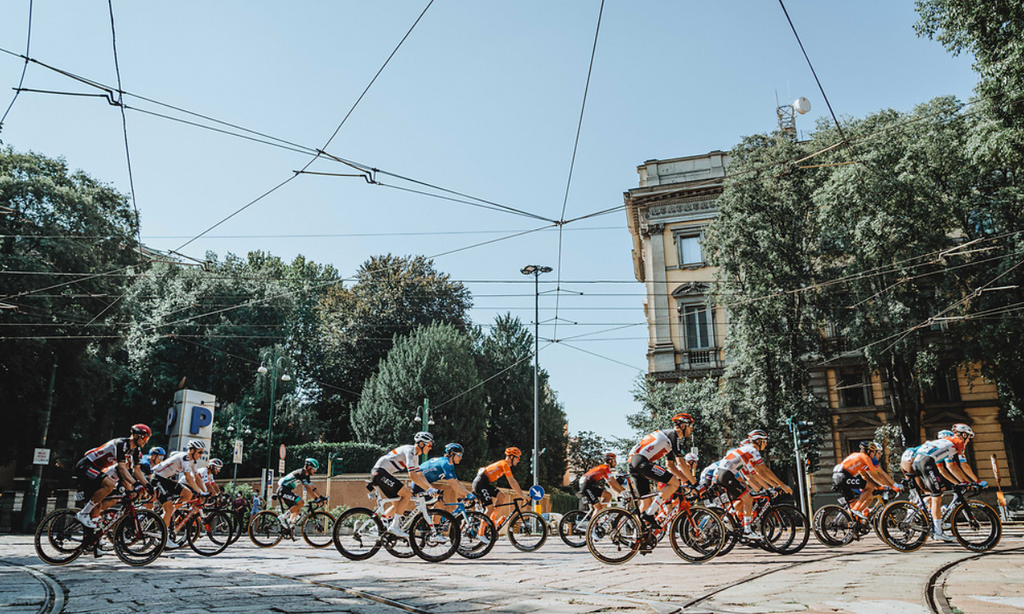The Road Book's Milan-Sanremo 2024 Preview

Introduction
With Pogačar’s brutal 80km solo ride at Strade Bianche, and Jumbo Lease-a-Bike’s alarming domination of not only the Opening Weekend, but also of Paris-Nice and Tirreno-Adriatico, 2024’s Spring calendar has already been one for the ages. What's more, we’ve not even hit the Monuments yet!
On Saturday however, that will all change with the 115th edition of Milan-Sanremo, a race which rewards patient watching, and patient riding - the longest day of the cycling season is defined every year by a short 3.7km stretch on which the race winning move will inevitably come. Often called the easiest Monument to finish, but the hardest to win (though in 1910 appalling weather meant that only 5 of the 63 starters finished a course blanketed by a blizzard of snow) Milan-Sanremo has a list of winners which is truly monumental. The race was first won by Lucien Petit-Breton, with the first Italian winner being Luigi Ganna in 1909 (he also won the first Giro d’Italia that year). Other historical winners include such names as Gino Bartal, Fasuto Coppi and Eddy Merckx a record seven times in the decade between 1966 and 1976. It was this period which truly earned the race a reputation as a sprinter’s Monument, though that has not necessarily been the case in recent years. Indeed, the last bunch sprint finish was won in 2016 by Arnaud Démare and the last 6 editions have been split evenly between small group breakaways and solo riders emerging victorious.
This was certainly the case last year, as UAE team emirates with Tim Wellens on the front drove a hard pace up the Poggio, Pogačar launched his attempt to breakaway 1.1km from the summit before Mathieu van der Poel’s vicious counterattack over the top and into the descent quickly saw him open up a gap, eventually running out the victor by 15 seconds. This was the first time since 2008 (when Fabian Cancellara finished 4 seconds ahead of Filippo Pozzato) that the winner has had a time gap back to second place, and van der Poel’s solo victory - 62 years after his grandfather Raymond Poulidor’s only Monument win - could be an indication of what to expect this season. He became only the 4th Dutchman to win the race, but with no rider able to defend the title since Erik Zabel in 2001, it is unlikely that van der Poel will be able to replicate his feat.

The Course
For the second year in a row, the 259.9km course won’t start it Milan itself, but rather the town of Pavia to the South, covering 45km of new terrain before re-joining the classic course. It will roll across the Po Valley plain before hugging the Mediterranean coast as it turns towards France. The longest of the classics is also one of the few Monuments suitable for sprinters as the race is mostly flat with the double-punch of the Cipressa and the Poggio the only climbs at a late enough point in the race to make any significant difference to the outcome.
These two short climbs are where the sprinters’ teams will be fighting to reign in the likes of Pogačar, Pidcock and van der Poel, all of whom will be looking to drive the pace up to an astronomical level and isolate themselves from the fast finishers. Before the peloton reaches these iconic features, they will have to tackle the not insignificant climb of the Passo del Turchino, though it comes far too early for a decisive move to be made on its slopes.
Only after 260km, the length of a full Tour de France stage, will the racing truly begin. First introduced in 1982, the Cipressa is the penultimate climb of the race. Although not the longest or steepest of climbs, only 5.6km long with an average 4.1% gradient (9% in places), its winding roads and the long day’s riding will be weighing on the sprinters' legs, giving the race's conductors UAE Team Emirates, INEOS and Alpecin-Deceuninck, the perfect chance to raise the tempo. We expect to see a number of sprinters distanced as the pace increases, and whilst the race winning move has come on these slopes before (Vincenzo Nibali in 2014, and Marco Pantani in 1999) the flat section which follows the Cipressa often neuters any time gains made on the climb.
16km later comes the iconic Poggio, first introduced in 1960 as an attempt to curtail the proliferation of sprint finishes and make the race more interesting. The climb is a perennially gruelling battle between the sprinter’s teams, and the specialists who are attempting to distance whatever is left of the fast men and get away in a small group or as a solo rider. It is here that the decisive move will come, and the tension will build throughout the day as viewer and rider alike attempt to anticipate who will launch it. The last three seasons have seen van der Poel (2023) Matej Mohoric (2022) and Jasper Stuyven (2021) all power away from the elite group to win in a solo attack. In particular, the last two winners used the fast and technical descent to open a gap to their rivals, and we’re certain that there will be some attempting to replicate that tactic this time around.
Pogačar and van der Poel’s titanic battle reached its apex here, with Pog’s attack 1.1km from the top of the Poggio probably coming too late as the Dutchman was able to burst past him, making the climb in a record time of 5 minutes and 40 seconds. These 6 minutes are some of the most exciting in cycling, and its 3.7km climb, with gradients barely reaching 8%, will be race defining. Pogačar has already demonstrated his ability to defy the cycling gods and launch long range attacks which leave his competitors incredulous and given van der Poel’s ability to out-descend him, we expect the Slovenian to launch an attack at the foot of the climb, if not earlier, whilst the Dutchman may well be one of those to attempt the same tactic as last year.
Whilst the climb itself is not particularly mammoth, it is the pace at which it is ridden, after such a long day in the saddle which makes it truly gruelling, and often breaks the spirit of the sprinters. With only 8km of racing remaining after the descent, any gap which can be made is likely to stick. However, if the sprinters teams do manage to tread firmly on the coat tails of the big-name climbers and hold the ragged remains of the peloton together till they reach Sanremo, its wide roads are perfect for an intense tactical battle for positioning, or a last gasp solo attempt. After an atrociously long course, positioning will be vital, and the riders who can use their teams with an astute strategic outlook throughout the day will be best positioned as it comes to a close on the final, arrow straight, 750 metres.

(A spectator watches the race unfold from their balcony in 2020)
Riders to Watch This Year
As befits the first Monument of the season, the preliminary startlist is replete with talent from cycling’s upper echelons. The Italian riders amongst the peloton turn out in force on what has been fertile home tarmac, Italians having taken 51 total victories at the race (Belgium next with 22) and there’s a long list of riders in attendance who will be hoping to reclaim this iconic race. Filippo Ganna (INEOS) finished a strong second last year and will certainly be of the opinion that he can go one better, and hopefully INEOS will focus on having him as their team leader for the race with Pidcock offering his supreme talent in support. Stage racing specialist Alberto Bettiol will turn out for EF Education-Easypost, and his experience at Grand Tours may help his team strategically, ensuring they can launch an attack at the opportune moment. Meanwhile, Jonathan Milan will be riding for Lidl-Trek and hoping his team can hold the race together and give him a chance to launch for a blistering sprint finish.
Jasper Philipsen (Alpecin-Deceuninck) is another sprinter who will be asking his teammates to keep the race tight, but whether he will be the focus of his team, rather than last year’s victor and current World Champion Mathieu van der Poel, remains to be seen. If he can stay with the bunch and tackle the Poggio in good time, you wouldn’t bet against him in a sprint. Fred Wright (Bahrain-Victorious) will be riding in support of Matej Mohorič after an unfortunately quiet Paris-Nice, but it’s always good to see a Brit, and a South-East Londoner to boot, riding with the best.
Previous winner Jasper Stuyven (2021), alongside teammate Mads Pedersen (both Lidl-Trek) will carry the hopes of their team. Given the calibre of sprinting talent on offer, Lidl-Trek are likely to push for a bunch sprint but expect them to also attempt to get a rider in any breakaway to ensure they can control the pace and reel it back in.
Soudal Quick-Step will have both Julian Alaphilippe and Kasper Asgreen in attendance, and all involved will hope that Alaphilippe is not as unfortunate as last year, crashing heavily before the real crunch of the race. If he can avoid misfortune, he’ll be able to conserve energy rather than turning on the afterburners to drag his way back to the bunch and may well be capable of taking a surprising, but very much welcome, victory. Caleb Ewen (Jayco-AlUla) has finished second twice and the Australian would always back himself in a sprint. Team Visma-Lease a bike will be represented primarily by Christophe Laporte who should never be undervalued, but it is clear that the race is not a priority for Dutch Super-Team.

(Pogačar grins at the camera as he destroys Strade-Bianche)
Even despite this roster of superstars, the two favourites will undoubtedly be last year’s victor and classics specialist Mathieu van der Poel, and UAE Team Emirates’ stellar Slovenian. Tadej Pogačar may not have raced since he demolished Strade Bianche, but we think that will actually be to his advantage. Most of the riders have been engaged in either Paris-Nice or Tirreno-Adriatico so will be feeling the extra miles in their legs once the race starts to heat up. Though getting some race-time under their belts is undoubtedly a benefit, Pog has already proved that he doesn’t need it this season. If he times the attack right, they will simply be unable to catch him. Pogacar is also supported by a strong team including Marc Hirschi, Alessandro Covi (Stage winner at the 2022 Giro d’Italia) and Tim Wellens. Last year van der Poel’s cunning and unrivalled descending skills were enough to beat Pogačar, but we think Poggi will dominate on the Poggio and emerge the victor. Until someone manages to ride 300km solo off the front, no other tactic than a late spurt up the Poggio seems possible...
Let us know what you think of our predictions over on social media, and if you want to read about a previous edition of the race, pick up the relevant Road Book using the code: RETRO20 for 20% off.
Written by Henrik Bassett
Photographs Courtesy of Russ Ellis
Contours from Milan-Sanremo

Leave a comment